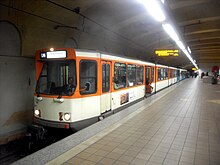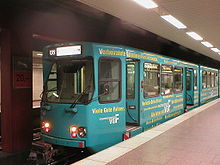SWF series P
| P-railcar | |
|---|---|
|
Ptb railcars at the Zoo station.
|
|
| Number: | 100 |
| Manufacturer: | DUEWAG |
| Year of construction (s): | 1972-1988 |
| Retirement: | 2007 Pt / since 2012 Ptb |
| Axis formula : | B '2' 2 'B' |
| Gauge : | 1435 mm ( standard gauge ) |
| Length over coupling: | 28,720 mm |
| Length: | 27,436 mm |
| Height: | 3596 mm |
| Width: | Pt: 2,350 mm / Ptb: 2,580 mm |
| Trunnion Distance: | 6,500 mm / 7,100 mm |
| Empty mass: | 34.5 t |
| Top speed: | 80 km / h |
| Installed capacity: | 2 × 120 kW = 240 kW |
| Impeller diameter: | 720 mm |
| Power system : | 600 V DC |
| Number of traction motors: | 2 |
| Coupling type: | Scharfenberg |
| Seats: | 62 |
| Standing room: | 180 (Frankfurt) |
| Floor height: | 97 cm |
As series P or P-railcar is a series of high-floor light rail vehicles in Frankfurt called. Various conversion variants resulting from the vehicles are referred to as the Pt and Ptb series.
history
The type P was developed from 1972 by the Düwag company for use on the Frankfurt am Main tram . In addition to the Mannheim type (from 1969), the Freiburg type (from 1971) and the type M / N light rail car (from 1975), it is one of the successors to the classic Duewag articulated wagons built from 1956 . The P-cars were built between 1972 and 1978. There are three series, the first series has already been taken out of service. A total of 100 railcars were ordered. The first delivery in 1972 comprised the 651–680 cars. They had folding steps and from 1974 were mainly used on the newly opened B line of the Frankfurt U-Bahn . The second delivery, which included wagons 681–716, had fixed steps compared to the first delivery and could only be used in the tram network. In order to be able to differentiate between the two series, it was decided to rename the 651–680 cars from P cars to Pt cars (t for tunnel-compatible). In 1977 and 1978, respectively, the third series, which comprised the 717-750 cars, was delivered. These were put into operation in the same years.
All series are 2.35 meters wide. Your engine power is 2 × 150 HP. With a length of 28.72 meters, the cars offer 62 seats and 180 standing places. The P-cars have a door width of 62.5 centimeters at the start and end of the car. The doors in the middle of the car are twice 59 centimeters wide.
The P railcars have a Simatic electrical control with a setpoint generator instead of a mechanical switching mechanism with a handwheel . Scharfenberg couplings are available at both ends of the wagon , with which multiple units of up to three vehicles are possible.
Conversions to the Pt and Ptb series
When the C line was opened in 1986 , the railcars 724-750 were converted into the Pt series. Since the expansion of the U7 underground line to Enkheim was put into operation in 1992 , the remaining P-cars 681–723 were equipped with folding steps. The P series has not existed since then. In order to be able to drive on the B and C routes in mixed operation with the 30 cm wider vehicles of the U2 and U3 railcars , the Pt wagons 692-750 were widened in the door area and thus became Ptb wagons (b for wide). The other remaining Pt wagons 651-691 have only been used on the tram since then. The Pt railcar 664 was converted into a driving school car in autumn 2005 and officially bears the number 2050 as a company car. The 2050 car was converted into a winter service vehicle in 2013 and received a snow plow on both front sides. Since then the car has been called the "Schneeschie-Bär". Between 2005 and 2006 many cars were equipped with stronger axles.
Due to vehicle breakdowns in the tram fleet due to accidents and maintenance, three Ptb vehicles (728, 738 and 748) were dismantled to Pt wagons in spring 2013 and were used on lines 12 and 18 as required from May 13th. With the delivery of further S-wagons , the use of the Pt-wagons in the late autumn of 2013 became unnecessary again. However, the three cars are still available as operating reserves. At the end of 2014, car 748, which is to be retained as a drivable museum vehicle, was returned to its original paint scheme in orange and light ivory. After the car type was withdrawn from regular operation in October 2016, the car was also included in the number range of historical vehicles in the following November and was given the number 148, as a combination of the number range of historical vehicles (1xx) and its old car number 748.
The same conversion, repainting and renumbering took place with the 738 (now 138) and 728 (now 128) cars.
The 720, 727, 736 and 749 cars have been reactivated since 2018 without repainting and run (mostly outside the school holidays) on lines 15 and 17.
Color schemes
With the P-cars, a new color scheme was introduced on the Frankfurt tram. Orange-light ivory replaced the light beige with green-gray decorative lines. This color scheme was mainly inspired by the pop color scheme of the 420 series S-Bahn vehicles . In the 1980s, the color scheme was also used on the Frankfurt subways and buses . In the 1990s, the VGF trains and buses were repainted again. The name of the paintwork is subaru vista blue, it is the current corporate color of VGF to this day. In the end, only the Ptb car 710 with the original paintwork was in use.
Retirement

Pt-Car 679 was the first to be retired after an arson attack by left-wing extremists in May 2001. Pt cars 669 and 670 collided head-on on the route to Frankfurt-Schwanheim . Because of the enormous damage, the vehicles were retired. Car 669 was parked in the corner home and car 670 in Neu-Isenburg . All three vehicles were cannibalized as spare parts donors. The remaining Pt wagons 651–691 were gradually retired from 2005 and parked in the Eckenheim wagon hall.
In order to be able to carry out the reinforcement trips at the soccer world championship 2006 without vehicle bottlenecks, the Pt cars 652, 659, 662, 668 and 672 were put back into operation. After the World Cup, they too were parked again in the Eckenheim car shed.
Since the city tunnel of the S-Bahn was closed for three weeks from July 31, 2006 to August 18, 2006 due to the renovation of the tracks and switches, replacement traffic was set up between Galluswarte and the zoo , which was given line number 10.
Since April 1, 2007, no Pt wagons have been used as planned. All vehicles parked were either in the Eckenheim depot or in the East depot. 25 railcars plus spare parts donors were sold to Gaziantep . The remaining railcars remained as an operating reserve. In 2009, twelve railcars remained, including railcar 690, which was to be preserved as a museum vehicle and was given the number 190. In 2010 the remaining eleven railcars were sold to the tram in the Upper Silesian industrial area . In spring 2012, the remaining units that were sold to Gaziantep but were still in Frankfurt were given up. The 190 museum railcar (ex 690) also had to be handed in because at that time it was not possible to do without another PtB car. In spring 2013, the 728, 738 and 748 cars were dismantled to Pt cars so that they could be used as reinforcement vehicles in tram operations. Car 748 was selected as a museum vehicle to be preserved and was given its original paint scheme at the end of 2014. In February 2018, car 738 was also converted into a museum vehicle
Since 2012, the Ptb cars on the C route have been gradually being replaced by new U5 vehicles ; on the U7 line, operations ended as early as 2012, on the U6 line only from 2013 as the U5 cars were only the older U2e cars should replace on the U7 line. Since 2014 there have been no more PtB cars on the C route. Ptb wagons ran on the U5 line until October 2016, as the construction of elevated platforms was not yet completed.
After completion of the elevated platforms at the Musterschule and Glauburgstrasse stations, there was no longer any need for the folding steps, which up until then had made the use of Ptb cars necessary. The company was switched to U5 vehicles, which were supposed to improve the operational situation through larger vehicle widths and more favorable door distribution as well as largely stepless entry. With the conversion, the last wagons were parked and are currently in the Eckenheim wagon hall, where they are waiting to be used again.
After accidents, Ptb-Wagen 703 in 2006, Ptb-Wagen 729 in 2008 and Ptb-Wagen 700 in 2010 have been retired. The railcars 700 and 703 were transferred to Gaziantep as spare parts donors in 2012.
commitment

The Pt wagons 651–691 were recently only used on trams. Since the S-wagons were ordered in 2003 and delivered in the following years, more and more Pt-wagons were decommissioned. Only during the 2006 Football World Cup were some Pt cars put back into operation and used tram lines 12, 14 and 20.

Until the elevated platforms at the Musterschule station were commissioned on October 9, 2016, the Ptb cars (692ff.) Only ran on the U5 line, on which they provided all traffic. Because of the maximum station length of 105 meters in Frankfurt, multiple traction of up to three vehicles was possible. Occasionally one or two courses drove on the U4 or U7, but operations on the U4 ended in 2010 because 16 U2h cars were converted into U2e cars and the Ptb cars were no longer needed on the U4. Due to the partly street-level stops without elevated platforms, only Ptb wagons with folding steps could run on the U5 line. Car 2050, formerly number 664, has been preserved as a driving school car. Car 663 was used as a training car for the fire brigade at the main station until it was replaced there in 2012 by an irreparably damaged U5 railcar and sold to Gaziantep.
Due to the higher demand for trams in tram traffic, three retired Ptb wagons were dismantled to Pt wagons in order to run there as scheduled vehicles. Two other vehicles, which were dismantled as vintage trams in 2013 and were given the old Frankfurt paintwork, have been back in regular service since summer 2018. The operation began in December 2018 and is expected to last until the delivery of new vehicles in 2021.
In the meantime, the decommissioned Ptb wagons 720, 727, 736 and 749 have also been converted back to Pt wagons, but not repainted, and are used on lines 15, 17 and occasionally 18 in the morning.
The further use of the remaining Ptb wagons is not known.







